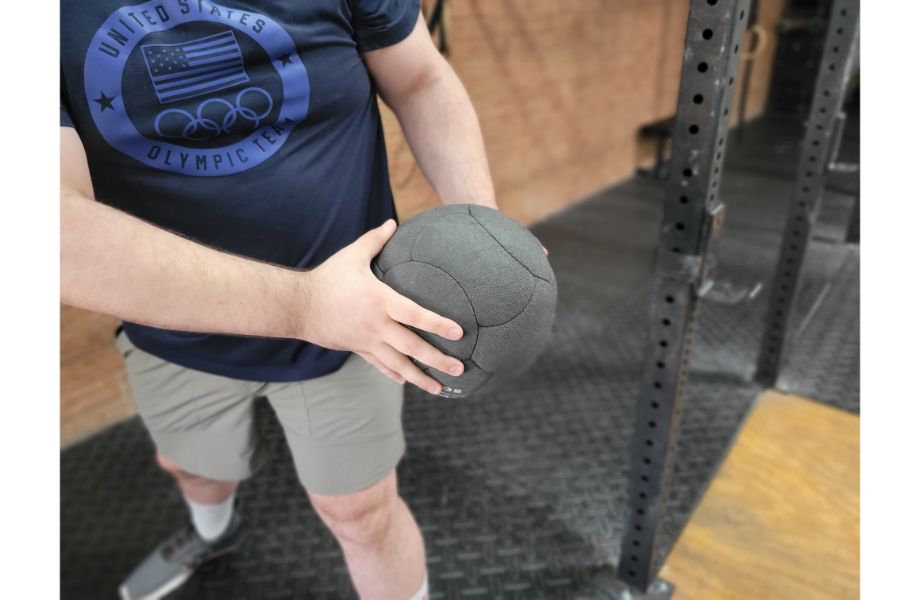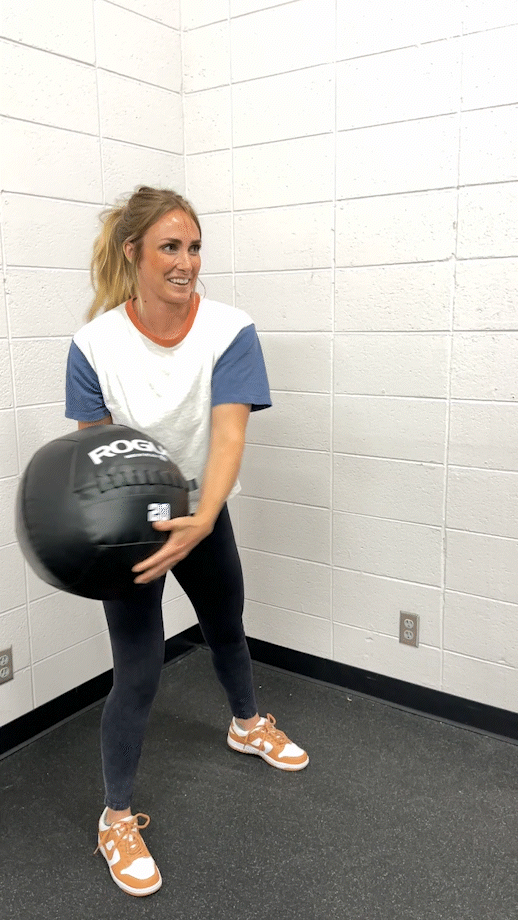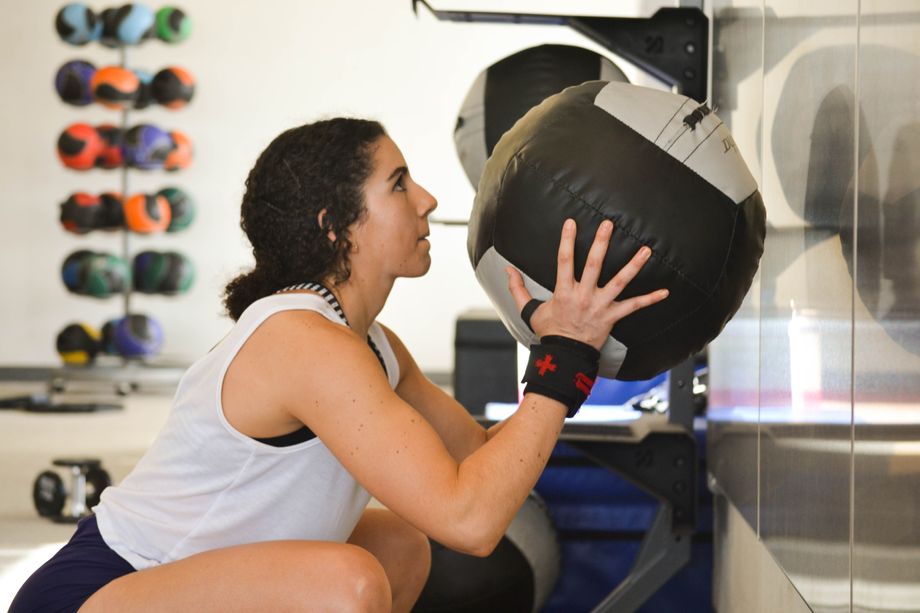We test and review fitness products based on an independent, multi-point methodology. If you use our links to purchase something, we may earn a commission. Read our disclosures.
Medicine ball workouts are fun, due to all the slamming and throwing, and are a fantastic tool to develop power and explosiveness—and it has been that way for almost 3,000 years. While the history details are unclear, med balls were supposedly used as far back as 3,000 years ago by Persian wrestlers looking to become stronger.
Then in the early 1900s, medicine balls regained popularity because of a game called “Hooverball.” Hooverball was similar to volleyball but with a medicine ball tossed over the net. President Herbert Hoover’s doctor suggested his patients use the med ball to get in shape, hence the name Hooverball.
Now you too can have a ball with these medicine ball workouts recommended by this certified personal trainer.
RELATED: Best Slam Balls
Medical disclaimer: This article is intended for educational and informational purposes only. It is not intended as a substitute for medical advice. For health advice, contact a licensed healthcare provider.
How to Use a Medicine Ball
The beauty of the medicine ball is its versatility, as it can be used for throwing, slamming, or as a tool to add resistance and intensity to traditional strength exercises like squats, push-ups, and deadlifts.
RELATED: What Muscles Do Push-Ups Work?
How to use a medicine ball depends on its use.

When using it for throwing or slamming, the point is to improve power. If the med ball is too heavy to throw fast, it wastes time. A great starting point is between 4-15 pounds, with a sweet spot between 6-10 pounds. When training, power is best to train at the beginning of your workout when you have the most energy.
If you’re using the medicine ball for core training or more traditional strength exercises like lunges, then the med balls’ size and weight are dictated by your form.
Because holding a medicine ball is different from holding a dumbbell or barbell, holding it securely while maintaining proper form is paramount. If form slips or it’s hard to hold, it is best to go down in weight.
Benefits of Medicine Ball Training
Besides playing with a ball, medicine balls challenge your balance and core strength and are a great way to add some pop to your workout. Here are four more critical benefits of med ball training.
Improved Strength
Medicine ball power exercises like slams and rotational throws involve rapid contractions of “fast-twitch” muscle fibers. These fibers have the biggest potential for improved hypertrophy and building strength.
Increased Calorie Burn
Because med balls use fast-twitch muscle groups of your arms and legs, this can increase the number of calories burned during the workout up to 14 hours later1.
Easy Way To Train Power
Olympic lifts are a fantastic way to develop full-body power and strength, but it takes time to master the technique. Med ball exercises are easy to pick up, great for the beginner to the advanced exerciser, and an excellent introductory method for training power.

Improved Athleticism
Med ball workouts can boost the speed and accuracy of your movements in the gym or on the sporting field, like when twisting or changing direction. The med ball’s freedom of movement and the ability to train in multiple planes of motion will prepare your body for realistic motions and may help prevent injuries.
RELATED: Cross-Training Exercises for Endurance Athletes
10 Best Medicine Ball Exercises
If you are stuck for ideas on incorporating medicine ball exercises into your workout routine, don’t worry—we have your back (and front).
1. Medicine Ball Push-Up
Why You Should Do It: There are a few variations of the medicine ball push-up, and you should do any of them to increase the intensity of this fantastic bodyweight exercise.
How to Do It:
Note: This is one variation of many.
- Place both hands on a medicine ball while kneeling on the floor.
- Step your legs back into a push-up position with your feet wider than shoulder-width apart.
- Squeeze your glutes and abs to keep your back neutral.
- Slowly bend your arms to lower your chest toward the med ball until you have reached your desired depth.
Push back up using your chest muscles and triceps to return to the starting position and reset and repeat.

2. Med Ball Mountain Climbers
Why You Should Do It: Mountain climbers work the core and train the hip flexors and lungs. Adding a medicine ball increases the intensity because of the decreased stability.
How to Do It:
- Set up in the front plank position with both hands on a med ball.
- Drive your left knee toward your chest, then return it to the plank position.
- Drive your right knee toward your chest, then return it to the plank position.
- Continue alternating sides for an even number of repetitions on each side.

3. Overhead Squat
Why You Should Do It: Squatting with the med ball overhead (i.e., with the weight farther away from the working muscles) increases the intensity of the squat using only a light load.
How to Do It:
- Hold a med ball in both hands at arm’s length in front of you. Raise it above your head until your biceps are by your ears.
- Position your feet in your preferred squat position and keep your chest up.
- Squat down until you reach your preferred depth.
Drive your feet into the floor to return to the starting position.

4. Russian Twist
Why You Should Do It: The med ball Russian twist will strengthen your anti-rotation muscles (obliques) and hip flexors.
How to Do It:
- Sit on the ground with your upper body upright and your legs straight, holding a med ball in both hands.
- Lift your feet off the ground and lean your torso back slightly with your shoulders down and chest up.
- Twist to the right and touch the med ball to the ground, then twist to the left and do the same.
- Continue alternating sides for an even number of repetitions.

5. Side Lunge
Why You Should Do It: Holding the med ball anteriorly adds intensity to the bodyweight side lunge while acting as a counterweight, allowing you to get in the side lunge position more easily.
RELATED: What Muscles Do Lunges Work?
How to Do It:
- Hold a medicine ball in both hands at chest height with your shoulders down and chest up.
- With the toes of both feet pointed forward, take a big step to the side with your left foot.
- Push back into your left hip and squat down while keeping your right leg straight.
- Push your left foot into the floor and return to the starting position.
- Either alternate sides or do all your repetitions on one side before switching.

6. Single-Leg Deadlift
Why You Should Do It: The med ball single-leg deadlift adds intensity to the bodyweight deadlift variation. Holding a med ball allows you to get into position easier because it acts as a counterbalance.
How to Do It:
- Hold a med ball in both hands in front of your waist.
- Soften your right knee and shift your weight to that leg.
- Hinge with your right hip while reaching your left leg up behind you. Allow the medicine ball to hang straight down as you hinge.
- Return to the starting position and repeat all the reps on one side before switching sides.

7. Medicine Ball Slams
Why You Should Do It: Medicine ball slams are a full-body power exercise that trains your core, shoulders, lats, and hips. Plus, they are simple to perform and burn a ton of calories.
How to Do It:
- Stand up straight with your feet shoulder-width apart and hold a light med ball in both hands.
- Bring the medicine ball up over and slightly behind your head, rise onto your tiptoes, and throw the ball onto the ground hard, using your whole body to do so.
- Catch the ball on the first bounce, reset, and repeat for the desired repetitions.

8. Overhead Medicine Ball Throw
Why You Should Do It: The med ball overhead throw strengthens explosive upper-body power in the chest, shoulders, and triceps and is a simple total-body exercise.
How to Do It:
Note: You’re going to need a wall to throw against.
- Stand 8-10 feet away from a wall and hold a light to medium med ball in both hands.
- Bend your elbows to approximately a 45-degree angle and bring the ball behind your head.
- Take a strong step forward with one leg, and throw the ball against the wall as hard as possible.
- Pick up the ball on the bounce and reset and repeat for the desired number of reps.

9. Rotational Medicine Ball Throw
Why You Should Do It: The med ball rotational throw trains the core powerfully while strengthening the obliques and hips simultaneously, making this exercise better than sit-ups.
How to Do It:
Note: You’re going to need a wall to throw against.
- Stand 2-4 feet away from a wall with your left side facing it, holding a med ball in both hands.
- Transfer your weight to your left hip while rotating your torso and throwing the ball against the wall. Remember, power comes from the hip rotation and not the arms.
- Catch the ball with both hands and reset and repeat.
- Repeat for an equal number of reps on the right side.

10. Med Ball Toe Touches
Why You Should Do It: The med ball toe touch works your whole body, but specifically helps develop core strength.
RELATED: Best Ab Exercises
How to Do It:
- Lie on your back with your legs straight and arms extended overhead, holding a medicine ball with both hands.
- Press your lower back into the floor. Exhale and contract your abs to lift your legs and arms simultaneously, reaching the med ball toward your toes. Sit all the way up, balancing on your hips while you touch the med ball to your toes.
- Lower back down with control, then repeat for the recommended number of repetitions.

Medicine Ball Workouts: Final Thoughts
The beauty of the medicine ball and its workouts is its versatility. You can easily add one to bodyweight workouts to make the exercises more challenging and improve your power by throwing and slamming the ball. Training with medicine balls will:
- Improve your strength
- Increase your calorie burn and fat-loss potential
- Train your body in various planes of motion
Medicine Ball Workouts: Q&A
Are medicine ball workouts effective?
When added to your strength training workouts, medicine balls will help improve strength and muscle potential because they train fast-twitch muscle fibers. These muscle fibers have the most significant potential for growth. So yes, they are very effective.
What exercises can I do with the medicine ball?
The beauty of this piece of equipment is the number of exercises you can do with it. You can throw it against the wall or floor and add resistance and intensity to bodyweight exercises like push-ups, squats, deadlifts, and lunges. You can easily get a full-body workout with a med ball.
Can a medicine ball help you lose belly fat?
Using the medicine ball for power moves like slams and overhead throws can help you lose belly fat because they will have you sucking in the air—after all, you’re using fast-twitch muscle fibers. But the driver of all fat loss is being in a caloric deficit, and a weight-loss-focused diet combined with these med ball workouts and some cardio will be a great start.
What is a good weight for a medicine ball workout?
An excellent weighted ball for these medicine ball workouts does not comprise proper form and allows you to complete all the reps as intended. A great starting med ball weight for most is between 4-15 pounds, with a sweet spot between 6-10 pounds. You can go with a heavier ball when you get stronger and more powerful.
References
- Knab AM, Shanely RA, Corbin KD, Jin F, Sha W, Nieman DC. A 45-minute vigorous exercise bout increases metabolic rate for 14 hours. Med Sci Sports Exerc. 2011 Sep;43(9):1643-8. doi: 10.1249/MSS.0b013e3182118891. PMID: 21311363.
Further reading

I went all the way to Laguna Beach to have a flex-off with the man, the myth, the legend: Jason Khalipa. Read more

Build bigger biceps by learning how to do the cable biceps curl. A personal trainer explains modifications, alternatives, and common mistakes to avoid. Read more

We’ve got the best air bike workouts to get those legs and those lungs burning during your next ride. Read more

Learn about the BCAA benefits and whether or not you should consider adding this popular supplement to your stack. Read more

